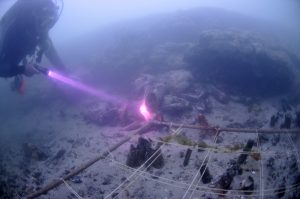 Bouldnor Cliff is an underwater Middle Stone Age site that dates to 6,000 BC. This was a time when the hunter gathering epoch was drawing to a close and when Great Britain was being separated from mainland Europe by sea level rise. The lowlands that lay between the two land masses covered around half a million square kilometres and would have been home to many family groups. They had developed wide-ranging trade links, moving along coastlines and rivers. The land they occupied was rich in vegetation, animals and wildfowl but ultimately it was all to be lost under the sea. These people had to adapt to the loss of land around them as the outline of modern Europe was taking shape.
Bouldnor Cliff is an underwater Middle Stone Age site that dates to 6,000 BC. This was a time when the hunter gathering epoch was drawing to a close and when Great Britain was being separated from mainland Europe by sea level rise. The lowlands that lay between the two land masses covered around half a million square kilometres and would have been home to many family groups. They had developed wide-ranging trade links, moving along coastlines and rivers. The land they occupied was rich in vegetation, animals and wildfowl but ultimately it was all to be lost under the sea. These people had to adapt to the loss of land around them as the outline of modern Europe was taking shape.
This period occurred when populations were growing following the last Ice Age. Migration into North West Europe was increasing but as people came, floods and tsunamis took the land away. Our understanding of these events is largely drawn from the archaeological record that now remains on land. But now, at Bouldnor Cliff we have the opportunity to enter the lost world below the waves and recover exceptional information from a site that keeps providing new surprises. Furthermore, the preservation of the material being recovered from the site is exquisite. String, wood, bone, foodstuff, ancient DNA of dog, auroch and wheat, the oldest boat building site in the world, as well as flint tools have all survived. Unfortunately, this is a race against time as erosion is steadily removing the submerged landscape and all the archaeology therein.
The site is unique in the UK yet it is invariably representative of contemporary sites that remain similarly buried across the North Sea and Channel. It lies at the foot of a seven metre high underwater cliff in the Solent: a channel that separates the Isle of Wight from Hampshire, England. The cliff is made of soft estuarine sediments that was deposited on the palaeo-landscape as the sea level rose; in the same way mud flats are formed alongside the edges of tidal rivers today. These relict mudflats have become covered by the sea and are now being cut by strong tides that form near vertical sections. These sections are continually eroding. As they retreat, archaeological horizons are being exposed and these too are being lost.
The Maritime Archaeology Trust has been monitoring the site and has identified areas of particular risk. From the 13 to 17th June 2016 a diving operation will be conducted to rescue exposed material and monitor rates of erosion. This will be the last such operation unless further funding can be found.
The project will gather data that can cast light on a number of themes that will be reviewed over the coming weeks. These are:
- The challenge of diving in a soup of silty water as the tide tries to carry you away.
- Woodworking and boatbuilding. Activities at Bouldnor Cliff and maritime travel in Mesolithic Britain.
- Erosion and loss of a unique Mesolithic site.
- 3D recording of prehistoric sites underwater.
- Coastal change and sea level rise.
- Technological sophistication of the Bouldnor Cliff families.
- DNA evidence: dogs, ancient cattle and wheat.
- Human dispersal. Challenges facing the people who first occupied modern Europe.
- Separation from mainland Europe. Lessons from the past!